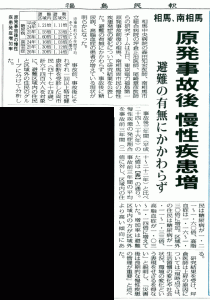Original Japanese written by staffer
The English below translated from the original Japanese by Heeday
The English translation edited by Rev. Dr. Henry French, ELCA
(Based on an article from the February 6th, 2016 edition of the Fukushima Minpo newspapers)
▼Click the image to enlarge it.

A survey team of medics published, on February 5th, 2016, survey results on fluctuations in occurrences of some chronic diseases among the citizens of two cities in Fukushima, Soma and Minamisome, before and after the meltdown of TEPCO’s Fukushima Daiichi. The survey discovered that, among both evacuees and non-evacuees, the number of diabetes and hyperlipidemia patients has been on the rise since the meltdown.
The survey covered a total of 6,406 citizens of the two cities, aged 40 to 74, who received a “medical checkup for seniors” both before and after the meltdown. The survey team divided the samples into two groups, those within the evacuation zones and those outside. The medics compared chronic disease occurrence rates during the three years following the 2011 meltdown, 2012 through 2014, with those during the three years before, 2008 through 2010. Those figures are shown in the table.
【Chronic disease increase rates after the meltdown】
| Inside evacuation zones | Outside evacuation zone | |
| Diabetes | ||
| 2012 | X 1.21 | X 1.11 |
| 2013 | X 1.55 | X 1.33 |
| 2014 | X 1.60 | X 1.27 |
| Hyperlipidemia | ||
| 2012 | X 1.16 | X 1.03 |
| 2013 | X 1.30 | X 1.12 |
| 2014 | X1.20 | X 1.14 |
* With “1.00” being the average over the three years immediately preceding the meltdown, for each disease
(Prepared by Heeday for the Project, based on the table in the newspaper article above)
With the average occurrence rates before the meltdown as the baseline, the samples within the evacuation zones showed a rise in diabetes by 1.21 to 1.60 times, and an increase in hyperlipidemia by 1.16 to 1.30 times. Those residents outside the evacuation zones also showed similar rising trends, 1.11 to 1.33 in diabetes and 1.03 to 1.14 in hyperlipidemia. The rates of increase tended to be greater among the residents of the evacuation zones than among those outside the zones.
Based upon those results, the survey team explained that “those rises in chronic diseases have to be, at this point, ascribed to changes in the residents’ lifestyles, social situations and environments.” The team also said, “After a major disaster, control of long-term, chronic diseases is a major issue.”
Following the Chernobyl disaster, we heard about increases in many diseases, not just those related to the thyroid. Compared to figures before the disaster, during the two years following the Chernobyl accident, cases of diabetes, chronic bronchitis, ischemic cardiac diseases, nerve system problems, stomach ulcers, chronic respiratory problems, and other diseases doubled to quadrupled among adults around the nuclear power plant. (This is based on a report made by the then Minister of Health of Belarus, at an unofficial meeting of the IAEA that convened in 1989.)
Today, more than 29 years after the Chernobyl disaster, many diseases are still on the rise. Some doctors in the region say that, in the current stage of related studies, especially with cancer cases, it is still too soon to make conclusive remarks on the actual health damage done to citizens by the disaster.
Then、with only some five years since the Fukushima tragedy, we are only seeing the beginning of the history of health damages from the meltdown. It will probably be decades before we can come to any conclusions about the cause-effect relationship between the meltdown and health hazards. So, facing this tough reality, what should we be doing now?
